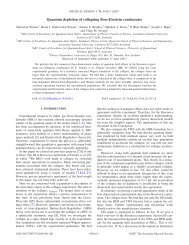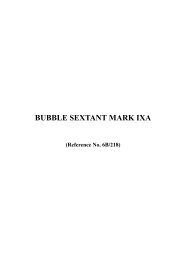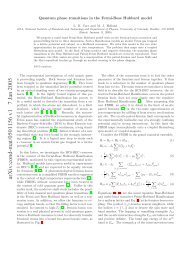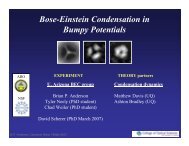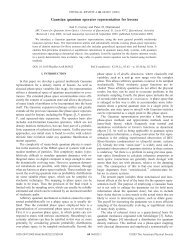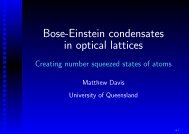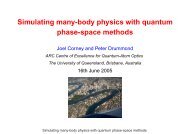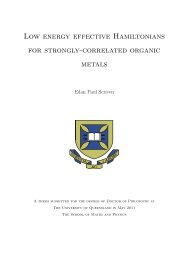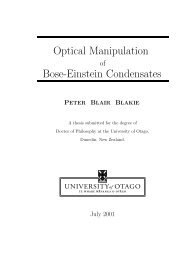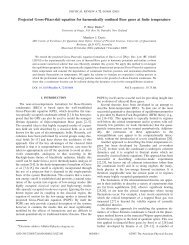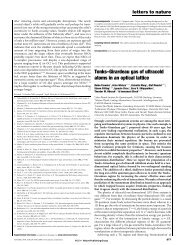Open Quantum Dynamics of Mesoscopic Bose-Einstein ... - Physics
Open Quantum Dynamics of Mesoscopic Bose-Einstein ... - Physics
Open Quantum Dynamics of Mesoscopic Bose-Einstein ... - Physics
Create successful ePaper yourself
Turn your PDF publications into a flip-book with our unique Google optimized e-Paper software.
3. Homodyne measurements on a <strong>Bose</strong>-<strong>Einstein</strong> condensatedrift (as we shall see in the fully quantum results), and that they are also damped. However,for short times, these equations do reproduce all the dynamics seen in the quantumresults.From the conditional master equation, we can write down a stochastic Shrödingerequation that explicitly gives the conditional dependence on the measured current I(t):d ∣ ˜Ψc (t) 〉 [= dt −iĤ2 − Γ ∣∣2 Ĵ x 2 + I(t)Ĵx]˜Ψc (t) 〉 , (3.23a)I(t) = 2Γ 〈 Ĵ x〉c + √ Γξ(t), (3.23b)where ∣ ∣ ˜Ψc (t) 〉 is the unnormalised ket describing the conditional state <strong>of</strong> the system, andwhere the stochastic term ξ(t) has the correlations〈ξ(t)〉= 0 (3.24a)〈ξ(t),ξ(t ′ ) 〉 = δ(t − t ′ ). (3.24b)Thus we can see how the system evolution is conditioned upon the measured current, andhow oscillations in the particle number difference 〈 Ĵ x modulate the current.〉cFor our purposes, it is more useful to consider the Shrödinger equation for the normalisedket that does not explicitly mention the detection current:d ∣ ∣Ψ c (t) 〉 =[−iĤ2dt − Γ (Ĵx − 〈 〉 ) 2 √Ĵ x2c dt + Γ(Ĵx − 〈 〉 ) ] ∣∣Ĵ x dW Ψcc (t) 〉 . (3.25)The terms in the equation due to the measurement depend on the quantity Ĵx − 〈 Ĵ x〉c .This is minimal in semiclassical type trajectories for which 〈 Ĵx2 〉c factorises to 〈 〉 2 Ĵ x c .Thuswe may expect that for some range <strong>of</strong> values <strong>of</strong> χ, the stochastic measurement terms woulddrive the system towards an oscillating trajectory for which 〈 Ĵx2 〉c ≃ 〈 〉 2 Ĵ x . The reducedcuncertainty in position would lead to momentum fluctuations, which in turn could drivetunnelling oscillations.3.4 SimulationsThe results <strong>of</strong> the simulations <strong>of</strong> Eq. (3.25) are shown in Figs. 3.2 to 3.8. Time is plottedalong the x-axis in units <strong>of</strong> t 0 =1/Ω. The strengths <strong>of</strong> the atom-atom collisions and theatom-field interaction were controlled by varying respectively the normalised variables Θ =κN/Ω andΓ=ΓN 2 /Ω. The parameters stated in Table 3.1 give the range <strong>of</strong> measurement69



